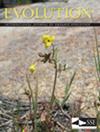简单模型下分类特征的相关演化。
IF 2.6
2区 环境科学与生态学
Q2 ECOLOGY
引用次数: 0
摘要
我描述了一个简单的模型,用于量化在系统发生树上演化的两个分类特征之间的关联强度。该模型可用于估算相关性统计量,即这两个特征是否倾向于同时发生变化(正相关)或在不同时间发生变化(无相关)。这与询问一个特征的变化是否与另一个特征的特定状态相关不同,后者是之前大多数分类特征系统发育相关性检验的重点。对模拟数据的分析表明,在不同的树大小和系统发育信号范围内,都可以准确地估计出正相关性。本文章由计算机程序翻译,如有差异,请以英文原文为准。
Correlated evolution of categorical characters under a simple model.
I describe a simple model for quantifying the strength of association between two categorical characters evolving on a phylogenetic tree. The model can be used to estimate a correlation statistic that asks whether or not the two characters tend to change at the same time (positive correlation) or at different times (no correlation). This is different than asking if changes in one character are associated with a particular state in another character, which has been the focus of most prior tests for phylogenetic correlation in categorical characters. Analyses of simulated data indicate that positive correlations can be accurately estimated over a range of different tree sizes and phylogenetic signals.
求助全文
通过发布文献求助,成功后即可免费获取论文全文。
去求助
来源期刊

Evolution
环境科学-进化生物学
CiteScore
5.00
自引率
9.10%
发文量
0
审稿时长
3-6 weeks
期刊介绍:
Evolution, published for the Society for the Study of Evolution, is the premier publication devoted to the study of organic evolution and the integration of the various fields of science concerned with evolution. The journal presents significant and original results that extend our understanding of evolutionary phenomena and processes.
 求助内容:
求助内容: 应助结果提醒方式:
应助结果提醒方式:


